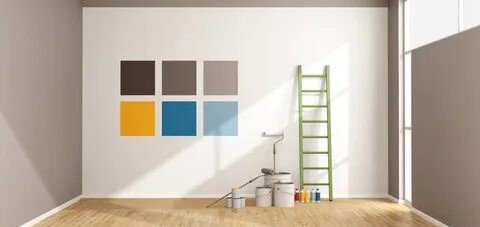Introduction: Why Prep Matters More than Ever in 2025
Interior painting can dramatically transform your space, adding color, personality, and style. But before you dive into choosing colors or finishes, there’s one critical step you cannot skip: wall preparation. In 2025, innovations in paint formulas demand a cleaner, smoother, and more precise surface to truly shine. Whether you’re doing a DIY project or hiring professionals, the quality of your prep will determine the final result.
1. Clear the Room and Protect Surfaces
Before starting any wall prep, you need a clutter-free space. Move furniture out of the room or to the center, covering it with plastic or drop cloths. Use painter’s tape to protect:
- Baseboards
- Light switches and outlets
- Door and window trim
- Flooring edges
Cover floors with heavy-duty drop cloths to prevent damage from dust, debris, or spills and clearing the room also reduces distractions, making the job more efficient and ensuring safety. In multi-purpose spaces like home offices or dining rooms, consider dismantling hardware and unplugging electronics before you begin.
Investing time to cover surfaces saves hours of cleanup and avoids accidents that can delay your painting schedule. If you’re prepping a large area, label furniture and hardware so you can reassemble quickly later.
2. Inspect Walls for Damage and Problem Areas
Walls might look fine at a glance, but small imperfections can ruin a paint job. In 2025, paint technology can emphasize flaws if not addressed.
Check for:
- Nail holes
- Cracks
- Peeling paint
- Water damage or stains
- Mold or mildew
Mark areas needing attention with painter’s tape so you don’t miss anything later, so take notes or photos for reference, especially in large rooms or homes with multiple problem areas.
If you notice deep gouges or previous poor patchwork, those may need extra attention or even professional evaluation. Do not ignore areas with bubbling or peeling paint, as these can be signs of moisture behind the walls.
For older homes, consider checking for lead paint and asbestos, especially if you’re dealing with walls from before 1980. In 2025, many municipalities will offer testing kits or certified professionals to help you identify health hazards safely.
3. Clean Walls Thoroughly
Even invisible dirt and oils can prevent paint from adhering correctly.
Cleaning Steps:
- Use a sponge or microfiber cloth with mild detergent and warm water.
- Pay extra attention to kitchens (grease buildup) and bathrooms (moisture residue).
- Rinse with clean water and allow to dry completely.
Pro Tip: For mildew, use a mixture of water and white vinegar. For grease, use a degreaser or TSP (trisodium phosphate). Always wear gloves and ensure proper ventilation when using strong cleaners.
For textured walls, gently scrub with a soft-bristle brush to lift dirt from crevices. If your walls have wallpaper glue residue, a solution of warm water and vinegar helps soften it for removal.
Skipping this step is one of the most common causes of peeling, uneven finishes, and discoloration over time.
4. Repair Holes, Cracks, and Imperfections
Before you paint, your surface must be even, so use spackling paste, joint compound, or wall patch kits to fix problems.
How to Fix Common Issues:
- Nail holes: Fill with lightweight spackle using a putty knife.
- Hairline cracks: Use flexible patching compound.
- Larger holes: Apply wall patches before spackling.
- Bumps or ridges: Sand them down for a smooth surface.
Let repairs dry thoroughly before sanding. If you’re dealing with repeated cracks, consider reinforcing them with mesh tape. After patching, run your hand over the area to check for flushness with the surrounding wall.
5. Sanding for Smoothness and Adhesion
Sanding isn’t just about smoothing repairs—it’s key to making paint stick. Use fine-grit sandpaper (120 to 220 grit) to:
- Remove gloss from existing finishes
- Smooth over patched areas
- Feather edges where old paint meets the repair
Use a sanding block or pole sander for larger areas, and always wear a dust mask and goggles. Sand in a circular motion, being careful not to gouge or overwork the surface.
After sanding, check the walls under good lighting. Run your hands across the surface to find uneven areas. The smoother the surface, the more professional your paint will look.
For large homes or rooms, consider using a drywall sander with a vacuum attachment, as these tools are a game-changer for cutting down on dust and speeding up the process.
6. Dust and Vacuum after Sanding
Dust from sanding can ruin a perfect finish. Always:
- Vacuum the walls with a brush attachment
- Wipe them down with a tack cloth or a damp microfiber towel
This ensures your new paint adheres cleanly and evenly. Leftover dust acts like a barrier, causing paint to bubble, crack, or peel over time.
In 2025, anti-static cleaning cloths have become popular for final wipe-downs, especially for high-end paint jobs. These cloths attract dust like magnets and reduce the chance of missed spots.
For best results, clean from top to bottom and repeat the process in high-traffic or dusty areas. If pets are in the home, double the effort as their hair can cling to surfaces and compromise your paint finish.
7. Prime the Walls (Even If Paint Has Primer-In-One)
Primer seals the surface, evens out color differences, and provides better adhesion. Don’t skip this step, especially in the following cases:
- Painting over dark colors
- Covering stains or repaired drywall
- Painting raw or patched surfaces
Choose the right primer:
- Stain-blocking primer for water damage or nicotine
- Bonding primer for glossy or slick surfaces
- Mold-resistant primer for humid rooms
Even if you use a paint-and-primer-in-one, separate priming can produce better results in tricky areas.
In 2025, low-VOC and odorless primers are the preferred choice for health-conscious homeowners. These formulas dry faster, are safe for kids and pets, and perform just as well as traditional options.
8. Use High-Quality Tools and Materials
Prep is only as good as your tools. For best results in 2025, use:
- Painter’s tape that’s easy to remove
- Durable sanding sponges or pole sanders
- Professional-grade spackle or patch kits
- High-quality primer and applicators
These might cost a little more upfront, but save time and frustration in the long run.
Don’t forget about lighting. Use LED work lights or daylight bulbs to spot imperfections you might miss with standard lighting.
9. Keep an Eye on Weather and Humidity
Paint prep depends heavily on the environment. Before priming or painting:
- Make sure the room is well-ventilated
- Check that the humidity is below 60%
- Avoid prep on extremely cold or hot days
High humidity can delay drying and affect adhesion.
In 2025, many smart home thermostats offer room-specific humidity readings. You can also purchase inexpensive hygrometers to measure indoor conditions manually.
Extreme temperatures and moisture can cause bubbling, cracking, or fading. Always follow manufacturer guidelines on temperature and dry times.
10. When to Call in the Experts
If your walls need serious repair, or if you’re painting multiple rooms or tricky areas like stairwells and vaulted ceilings, it might be time to hire professionals.
At Carter’s Painting Services, we offer wall preparation and painting services tailored to your needs.
We also handle:
- Wallpaper removal
- Popcorn ceiling smoothing
- Custom texture matching
- Eco-friendly material sourcing
Let us help you avoid the time sink and errors that can delay your project or increase your costs.
How Carter’s Painting Services Helps You Prep like a Pro?
DIY wall prep takes time, patience, and expertise.
What We Offer:
- Comprehensive wall inspections
- High-quality repairs and patching
- Precision sanding and surface smoothing
- Custom priming for your wall conditions
- Clean, safe, and eco-friendly techniques
Whether you’re tackling a single room or your entire home, we make sure every wall is paint-ready with zero stress. Contact us for a free consultation at https://carterspaintingservices.com/


